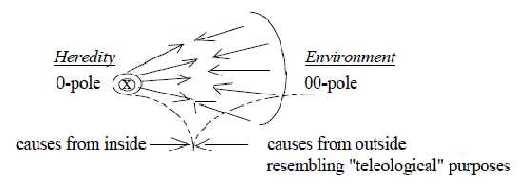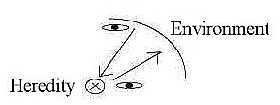Heredity:
the factor from inside, with the
embryo cell as the center, the 0-pole
in our model. Environment:
the factors from outside, from the
surrounding world, as anticenter,
the 00-pole.
 Fig
HE-1-199-1 All the processes
of biological evolution, those that
are called random mutations and
those implying selection, adaptations
to environment, can be described
as results of the opposite forces:
as processes between divergent forces
from inside heredity and the differentiating,
polarizing forces from outside the
environment. The
two poles heredity and environment
has naturally a common source, the
same root in an underlying "whole",
which constitute the binding force
between them. (And the environment
for an organism is not least other
organisms, others’ heredity.). An
organism as a 0-pole is half of
the whole. It’s 1/2
on many different inner chemical
and biological levels, which are
expressed in "needs". Of water,
food (energy), communication… With
such a commonplace description,
using terminology from the dimension
model, it becomes perhaps easier
to understand an evolution towards
superposed levels and more and more
complex organisms as given, as a
process through dimension chains
and level chains
.
 Fig
HE-2-182-2 Fig
HE-2-182-2 *
Cf. sexual reproduction often at
changes of environment. Only
random mutations and "natural selection"
through the survival of the best
adapted (this circular definition)
can hardly explain the further evolution
from immensely well adapted bacteria.
Some
words about and "random"
mutations, the concept "chance"
: If it should exist real chance
and not only causes practically
difficult to determine, it could
be illustrated as a certain direction
of movement outwards in a not yet
defined or homogeneous surrounding.
The direction of locomotion cannot
in this case be specified in relation
to "north-south-east-west" or anything
else, it becomes "random". A
specified surrounding reduces chance
– governs the development towards
the causally determined.
"Natural
selection" could be described
in terms of "counter-directions".
When an organism
with a certain inheritance meets
a suitable environment, it may be
interpreted as a relation between
complementary poles of equivalent
energy, which maintains vital processes,
simply illustrated for individual
1 in the figure below.
Individual
2 has to develop or change environment
not to die.  Heredity
– Environment Fig
HE-3-200-1 Heredity
– Environment Fig
HE-3-200-1Rotation
of arrows from environment in the
figure gives a favorable counter-direction
for individual 2.
Where
goes in reality the border between
heredity and environment?
Earlier,
it has surely most often been drawn
at the birth of a child, but also
the circumstances during embryonic
stage in the womb are an environment
and naturally chemicals in blood
from the mother.
Should
we perhaps also regard all cytoplasm
with organelles in the cell, all
but DNA as environment?
If
RNA from the mother in cytoplasm
of the first egg cell as it is said
is responsible for first cell divisions,
this RNA is perhaps varying dependent
upon "outer" circumstances and hence
an environmental factor?
Cf.
in later decades new insights within
epigenetics.
About
viewpoints: There is a tendency
to stress the importance of heredity
in direction of sight inwards –
backwards towards past times and
downwards towards social strata.
While the importance of environment
is stressed in opposite direction
of sight, towards the future and
upwards in the hierarchies. It becomes
actually a consequence of the sight
directions (cf. fig. 1 above):
 Fig
HE-4-200-2 Fig
HE-4-200-2
Both
heredity and environment are natural
phenomena, "given by Nature"
as poles out of the whole. When
there is talk about aggression as
a part of human heredity and not
possible to change, only control,
the speakers seem to forget that
this will to control the evil results
of heredity is given by Nature too,
by definition.
The
same concerns such things as the
contamination of environment by
human beings with for instance chemical
pollution or radioactivity. Regarded
from some "objective" or inorganic
position, outside existing plants
and animals, the ’human’ behavior
could look like a driving force
of Nature towards increased frequency
of mutations for eventual other
new species to arise (perhaps as
a result of mankind’s evolution
towards the 00-pole – and a turn
to inward direction = a tendency
to suicide. Unfortunately, both
the destruction of environment and
the forces that want to save it
have to be understood as forces
of Nature.
|

 Fig
HE-2-182-2
Fig
HE-2-182-2 Heredity
– Environment Fig
HE-3-200-1
Heredity
– Environment Fig
HE-3-200-1 Fig
HE-4-200-2
Fig
HE-4-200-2